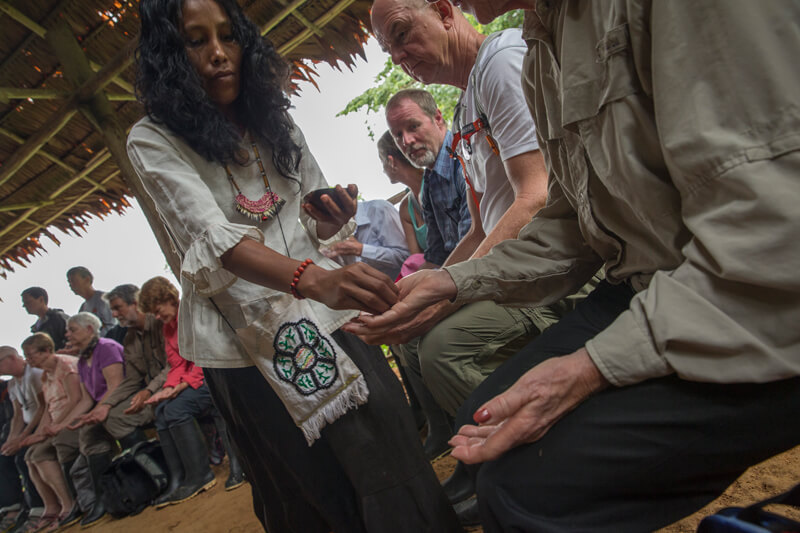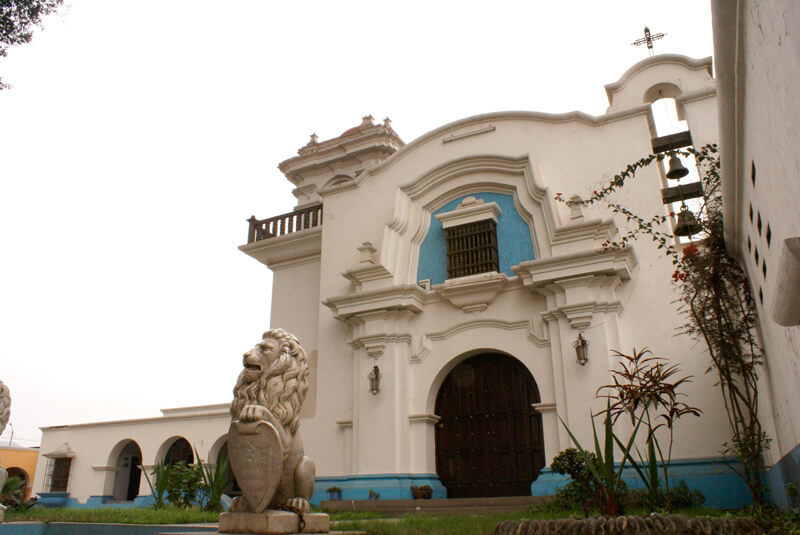A jungle journey
 In the humid morning following a short but torrential rainfall the rising sun glistens on rows of silver fish neatly spread over leaves on a table hewn from branches. Next to them is a wooden house perched on stilts where a chicken sits on her fluffy brood and colourful cockerels scratch in the mud.
In the humid morning following a short but torrential rainfall the rising sun glistens on rows of silver fish neatly spread over leaves on a table hewn from branches. Next to them is a wooden house perched on stilts where a chicken sits on her fluffy brood and colourful cockerels scratch in the mud.
With translation by our guide Victor, the owner – a member of a remote Amazonian tribe who speaks one of many ethnic languages and whose community can only be reached by boat – explains that once dried the fish will help feed his family through the winter. For these people the Peruvian rainforest is a natural superstore, providing everything they need for food, house building, children’s toys and medicine.
The latter is most markedly demonstrated that afternoon when we visit a shaman; also notably a woman. Practising animism, the belief that trees, plants and creatures possess a spirit, Carola lines up rows of old bottles containing indefinable liquids she creates from plants revered for their medicinal properties, and often involving lengthy treks to find them. Combined with her healing rituals, her eco-pharmacy provides the health care for nine villages.
 Victor talks about the worrying rise in South American charlatans who ‘promise’ tourists’ spiritual awakening – sometimes with fatal consequences – with the use of ayahuasca, a hallucinogenic drink taken during shamanic ceremonies and which Carola imbibes twice weekly. She shows us the bottle, but naturally there is no question of us trying it. Instead, she demonstrates the wonderfully named dragon’s blood, a deep red tree sap that turns milky white on the skin and soothes cuts, bites and other irritations.
Victor talks about the worrying rise in South American charlatans who ‘promise’ tourists’ spiritual awakening – sometimes with fatal consequences – with the use of ayahuasca, a hallucinogenic drink taken during shamanic ceremonies and which Carola imbibes twice weekly. She shows us the bottle, but naturally there is no question of us trying it. Instead, she demonstrates the wonderfully named dragon’s blood, a deep red tree sap that turns milky white on the skin and soothes cuts, bites and other irritations.
Sitting in a circle as Carola chants and blows smoke over us to attract good spirits – and irrespective of any individual faiths – we feel we’re in a very special place sharing something totally authentic that’s far removed from mainstream tourism. It’s an impression that remains with us all week.
 Our journey had begun in Lima. With so many visitors to Peru heading for the magnet of the ancient Incan city of Machu Picchu it’s capital city is often overlooked, and unfairly so. We appreciated time to discover the UNESCO-listed centre, typified by beautifully ornate Moorish wooden balconies and the grand Plaza Mayor square with the noon changing of the guard ceremony. Other distinctive neighbourhoods include Barranco, an artistic neighbourhood with individual galleries, shops and bars. It’s here that British-born Mari Solari, who moved to Peru in the 60s, champions the traditional and beautifully intricate craftwork of Peru’s indigenous tribes inside her combined home and gallery, Las Pallas. It’s a treasure trove showcasing the rich creative tradition. Items range from hugely detailed wall hangings to tiny charms – each one with a story that Mari can relate.
Our journey had begun in Lima. With so many visitors to Peru heading for the magnet of the ancient Incan city of Machu Picchu it’s capital city is often overlooked, and unfairly so. We appreciated time to discover the UNESCO-listed centre, typified by beautifully ornate Moorish wooden balconies and the grand Plaza Mayor square with the noon changing of the guard ceremony. Other distinctive neighbourhoods include Barranco, an artistic neighbourhood with individual galleries, shops and bars. It’s here that British-born Mari Solari, who moved to Peru in the 60s, champions the traditional and beautifully intricate craftwork of Peru’s indigenous tribes inside her combined home and gallery, Las Pallas. It’s a treasure trove showcasing the rich creative tradition. Items range from hugely detailed wall hangings to tiny charms – each one with a story that Mari can relate.
 Some members of the G Adventures’ group joined optional organised tours, while others explored individually, uncovering gems such as the Amaz restaurant, which provided a taste of things to come with its fresh and contemporary take Amazonian jungle food (albeit I bypassed the giant snails and opted for tasty vegetarian dishes instead). Peru is a leading exporter of organic coffee and caffeine fans won’t want to miss the Neira Cafe Lab in Miraflores where Harry Neira lovingly roasts and grinds quality coffees and hosts tastings. His enthusiasm and knowledge is infectious, and it’s no surprise he is at the forefront of Lima’s artisan caffeine scene.
Some members of the G Adventures’ group joined optional organised tours, while others explored individually, uncovering gems such as the Amaz restaurant, which provided a taste of things to come with its fresh and contemporary take Amazonian jungle food (albeit I bypassed the giant snails and opted for tasty vegetarian dishes instead). Peru is a leading exporter of organic coffee and caffeine fans won’t want to miss the Neira Cafe Lab in Miraflores where Harry Neira lovingly roasts and grinds quality coffees and hosts tastings. His enthusiasm and knowledge is infectious, and it’s no surprise he is at the forefront of Lima’s artisan caffeine scene.
The next day a flight of less than two hours transported us to a completely different world and at Iquotos, a bustling riverside town founded by Jesuit missionaries, we boarded Amatista. The intimate 30-passenger vessel takes passengers deep into the rainforest along a stretch of South America’s largest river and deep into the 8,000-square-mile Pacaya-Samiria Reserve, Peru’s largest protected habitat.
We were woken early the following morning – watches already discarded to tune into jungle time – and it was impossible not to feel in awe of the dense rainforest stretching like a vivid green mantle as far as the eye could see. Covering 60% of Peru, more than any other Amazonian country, it is home to only 6% of its population yet the diversity of its flora and fauna is unmatched anywhere else on the planet.
 Boarding Amatista’s two skiffs, we went on an early expedition to make the most of daybreak wildlife spotting opportunities and arrived back to avoid the sultry heat of midday when the rainforest sleeps. As the boat glided through the glassy water filled with floating hyacinths our guide mimicked the call of passing birds, which responded, and picked out sleeping sloths, and a line of tiny Pinocchio bats sleeping in a perfect line on a tree. By late afternoon we set off again, and the dusk heralded the onset of the evening jungle shift. These outings heralded some of the most dramatic moments. One night we sheltered under the industrial waterproofs provided by the boat as an electric storm pierced the sky. Later Victor plunged his bare hands into the water by the shoreline and skilfully plucked out a caiman, a small but equally fearsome member of the alligator family. We were able to get a close look before he released it to swim silently away.
Boarding Amatista’s two skiffs, we went on an early expedition to make the most of daybreak wildlife spotting opportunities and arrived back to avoid the sultry heat of midday when the rainforest sleeps. As the boat glided through the glassy water filled with floating hyacinths our guide mimicked the call of passing birds, which responded, and picked out sleeping sloths, and a line of tiny Pinocchio bats sleeping in a perfect line on a tree. By late afternoon we set off again, and the dusk heralded the onset of the evening jungle shift. These outings heralded some of the most dramatic moments. One night we sheltered under the industrial waterproofs provided by the boat as an electric storm pierced the sky. Later Victor plunged his bare hands into the water by the shoreline and skilfully plucked out a caiman, a small but equally fearsome member of the alligator family. We were able to get a close look before he released it to swim silently away.
 Unlike some safaris, Amazonian Peru is not about ticking off boxes when you sight large, and often uncamouflaged creatures. The magic of the rainforest is having your eyes opened – courtesy of the guides – to tiny tree frogs, insects, snakes and mammals that make their home in the water and dense forest canopy. One day Victor made us wait for he heard an almost imperceptible (to us) rustling high in the trees. We stood patiently and minutes later were rewarded with the joyful sight of a colony of squirrel monkeys running and leaping through the forest.
Unlike some safaris, Amazonian Peru is not about ticking off boxes when you sight large, and often uncamouflaged creatures. The magic of the rainforest is having your eyes opened – courtesy of the guides – to tiny tree frogs, insects, snakes and mammals that make their home in the water and dense forest canopy. One day Victor made us wait for he heard an almost imperceptible (to us) rustling high in the trees. We stood patiently and minutes later were rewarded with the joyful sight of a colony of squirrel monkeys running and leaping through the forest.
 At night, we read up on the many birds, animals and insects we’d seen during the day and relaxed over tasty meals followed by drinks in Amatista’s open-air bar; conversations interspersed by the sound of some of the rainforest’s innumerable residents.
At night, we read up on the many birds, animals and insects we’d seen during the day and relaxed over tasty meals followed by drinks in Amatista’s open-air bar; conversations interspersed by the sound of some of the rainforest’s innumerable residents.
The Amazon is often referred to as the “lungs of the earth”, producing around 20% of the world’s oxygen. Our incredible adventure also introduced us to its heartbeat and the very essence of what makes this incredible eco-system tick.











